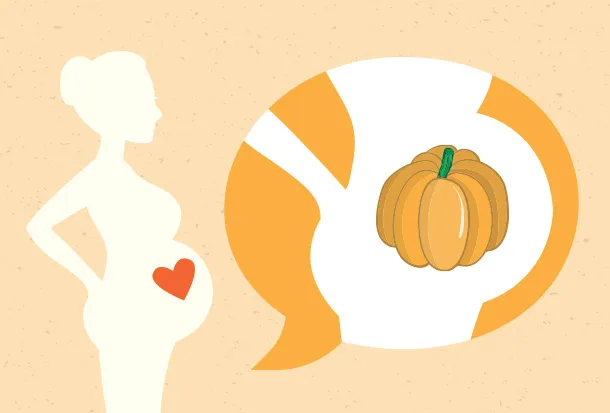The 35th week of pregnancy is a crucial time for the mother-to-be. The accompanying ailments are getting worse. She is already tired of them and is looking forward to giving birth. If she has a multiple pregnancy, this may be the last chance to prepare before the imminent termination. What the child looks like in 35. Week of pregnancy? What about mom's well-being? How to take care of yourself and what to think about before welcoming a toddler into the world? Check it out!
The 35th week of pregnancy – what month is it and what changes?
The 35th week of pregnancy is her 8th. Month – and the middle of the third trimester. A woman’s uterus already resembles the size of a watermelon. The baby is big, but he is still about a kilogram short of his birth weight. So it continues to grow and take up more and more space, putting pressure on mom’s internal organs. New, usually very troublesome pregnancy symptoms appear, including an unexpected nagging fear of childbirth.
Thoughts about the course of labor vex women giving birth for the first time the most. Fear of the unknown, on the other hand, is perfectly natural: it is then worth taking advice from a doctor, midwife or more experienced moms.
How the body is changing at 35. Week of pregnancy?
W 35. week of pregnancy the belly of the future mother is already really big – the uterus reaches the size of a sizable watermelon. It is assumed that by this stage women’s weight increases by about 12 kilograms, but due to water retention in the body and edema, the last weeks of pregnancy may be characterized by excessive weight gain.
During this period The bottom of the uterus is located just below the rib arches. It is still filled with a large amount of amniotic fluid. High abdomen puts pressure on internal organs gastrointestinal tract, especially the stomach, as well as the diaphragm and lungs, which exacerbates unpleasant discomfort. From 36. The week of pregnancy will begin to slowly decrease, so breathlessness and stomach problems should subside somewhat. Then, in turn, pressure on the bladder and pubic bone may occur.
During this period, there may also already be predictive contractions, which begin about 3 weeks before delivery. The abdomen hardens, there is a pulling sensation in the lower abdomen and non-salivary pain, sometimes accompanied by slight nausea or diarrhea. When you begin to feel contractions regularly and more strongly, and they do not pass when you change positions, for example, these may be signs of impending labor.
Pregnancy complaints at 35. Week – what to pay attention to?
W 35. A week of pregnancy, the ailments are already starting to become very troublesome for the woman. However, they are a natural sign that the toddler is growing and the body is beginning to prepare for delivery. These often new and unpleasant symptoms include:
- Shortness of breath, which is caused by the child’s pressure on the diaphragm. This will pass, and in the meantime it’s a good idea to just rest a little more, preparing for the next stage – motherhood. Non-assisted breathing difficulties or shortness of breath are also natural. However, if they appear suddenly and have an acute course, you should see a doctor as soon as possible.
- Heartburn caused by pressure on the stomach. Heartburn can be relieved somewhat by changing the position of the body. Laying on the left side prevents stomach acid from backing up into the esophagus and greatly improves the feeling of well-being. Milk, buttermilk, kefir and flaxseed can also help ad hoc, providing quick relief from burning and burning in the esophagus.
- Frequent running to the toilet. This is also a completely normal phenomenon during this period of pregnancy – and should not cause anxiety. Pressure on the bladder can also cause incontinence. This is quite embarrassing, but understandable in a pregnant woman and the use of appropriate sanitary pads is sufficient. Instead, daily Kegel muscle exercises can help prevent this.
- Abdominal pain. W 35. Week of pregnancy is mainly due to the stretching of the uterus, which must accommodate a gaining toddler. On the other hand, it can also herald childbirth, especially in the case of multiple pregnancies.
- Leg cramps, which occur mainly at night. Their cause may be swelling or magnesium deficiency. It is worth considering supplementation with this element with your doctor. Moms-to-be also often have decreased iron levels, which can lead to anemia. Iron deficiency in pregnancy must be supplemented, although the effect of supplementation may be constipation.
What is the size and weight of the child in 35. Week of pregnancy?
During this period, the toddler usually weighs more than 2 kilograms and measures about 40 centimeters. On the commissioned in 35. The week of the ultrasound you can see him sucking his thumb or his whole fist. This is the time when the child grows intensively – it should gain weight about 150-200 grams per week, while increasing its body fat. Observation of the child’s weight gain during follow-up visits allows the doctor to detect abnormalities. If you are planning a natural childbirth, too much toddler weight can complicate matters.
What does child development look like at 35. Week of pregnancy?
During the ongoing 35. Week of pregnancy, the toddler is preparing to function Outside the mother’s body, among others. drinks fetal waters and then pees – This ensures proper kidney function. His intestines begin to accumulate more and more meconium, which they expelled in the first few hours after birth. This substance is produced from swallowed amniotic fluid, fetal smear and bile.
The baby also accumulates antibodies that will protect it from infections shortly after birth, and stores iron. The toddler already has its own immune system – functioning independently of mom’s body – which will continue to develop after birth, especially through natural food, colostrum and milk.
From the beginning of the 35th week, the baby in the womb begins to react more strongly to external stimuli. If his mom hooks him, he will probably retaliate with a kick. He also wriggles frequently, which can cause awakenings from sleep. What’s more, it also visibly turns to emerging light sources. Reflexes such as sucking and grasping are already well mastered. It is prepared to breathe.
W 35. The week of pregnancy the toddler is invariably very active, while it has less room to train, so the baby’s movements are usually less noticeable. Strong uncontrolled kicks slowly give way to targeted movements such as thumb or fist sucking or grasping the umbilical cord.
Is there a risk of preterm labor?
Dissolution during this period is very likely, especially if it is 35. one week of twin pregnancy. Most such pregnancies end in preterm labor due to lack of space in the uterus. Twins born earlier often require assistance with breathing, but this is not the rule – it is not uncommon for them to do very well on their own. Babies from multiple pregnancies are born smaller, but in the following months they gain weight and develop properly.
In the case of twins, the termination is carried out by cesarean section, although there is no contraindication in the finished 35. A week into the pregnancy, the birth went naturally. Nevertheless, doctors do not want to risk possible complications during its course.
Any pregnancy that is terminated after 37 is considered a termination. Week, while as early as 35. A week, the baby’s body functions smoothly enough that it has a very good chance of adapting quickly to life outside the womb without any complications.
What tests to do in 35. Week of pregnancy?
At this stage of pregnancy, KTGs are performed every two weeks. W 35. Week of pregnancy, the doctor may order a standard general urine test and blood count. Between 35. a 37. Week of pregnancy mom must also take a strep test B group (GBS testing), for which a doctor’s referral is needed. This test involves performing a culture from material taken from the vaginal vestibule and anal area. The specialist may still recommend assessing the risk of the onset or severity of depressive symptoms.
How to make the most of the last few weeks until the end of pregnancy? Tips for moms-to-be
- Finish completing the layette for yourself and your baby. If you haven’t got everything ready yet, don’t leave shopping to the last minute – remember that the pregnancy calendar is not an oracle. Picking out clothes, the first few toys and accessories will also occupy your thoughts, calm the worries that take on a life of their own as the due date approaches, and give you plenty of joy.
- Prepare a birth plan and pack a suitcase. You should write up a birth plan with your doctor or midwife and gather in it all your expectations regarding (especially) the place and conditions of delivery, the presence of an attendant, consents (or lack thereof) for medical procedures, as well as pain relief and perineal protection. Pack all the things you need in the hospital.
- Massage the perineum, exercise the Kegel muscles. Remember to massage the perineum, do it already every day – this way you reduce the risk of rupture, as it becomes more stretchy. Spend a few more minutes a day stretching your pelvic floor (Kegel) muscles. With training, you will strengthen them, so childbirth will go more smoothly and you will get back into shape faster. Also try not to hold urine, and empty the bladder completely when visiting the toilet.
- Don’t downplay concerns and bad mood. Fear of childbirth is quite natural and you should not stifle it inside you. Talk about it with the people closest to you, as well as with your doctor or midwife or mom friends. If you’re plagued by a bad mood, don’t just put it down to feeling worse, but consider consulting a specialist.
Also think about the baby shower – it’s a relatively new, but really enjoyable tradition that brings a lot of joy and leaves behind beautiful memories.
FAQ:
- What is the size and weight of the child in 35. Week of pregnancy?
W 35. Week of pregnancy, the baby already measures about 40 centimeters and weighs just over 2 kilograms (about 2,300 grams on average). The uterus is the size of a ripe watermelon.
- What tests to do in 35. Week of pregnancy?
In addition to the standard (general urine test, blood count) between 35. a 35. t.c., a GBS test for group B streptococcus, or culture from the vaginal vestibule and anal area, should be performed.
- Which pregnancy ailments intensify at 35. week?
W 35. week of pregnancy, the uterus still presses hard on the diaphragm and stomach, hence shortness of breath, difficulty breathing and heartburn may increase. As the abdomen begins to lower, the urge to push on the bladder intensifies, resulting in more frequent visits to the toilet and usually uncontrollable urine leakage.
Rate this article:










